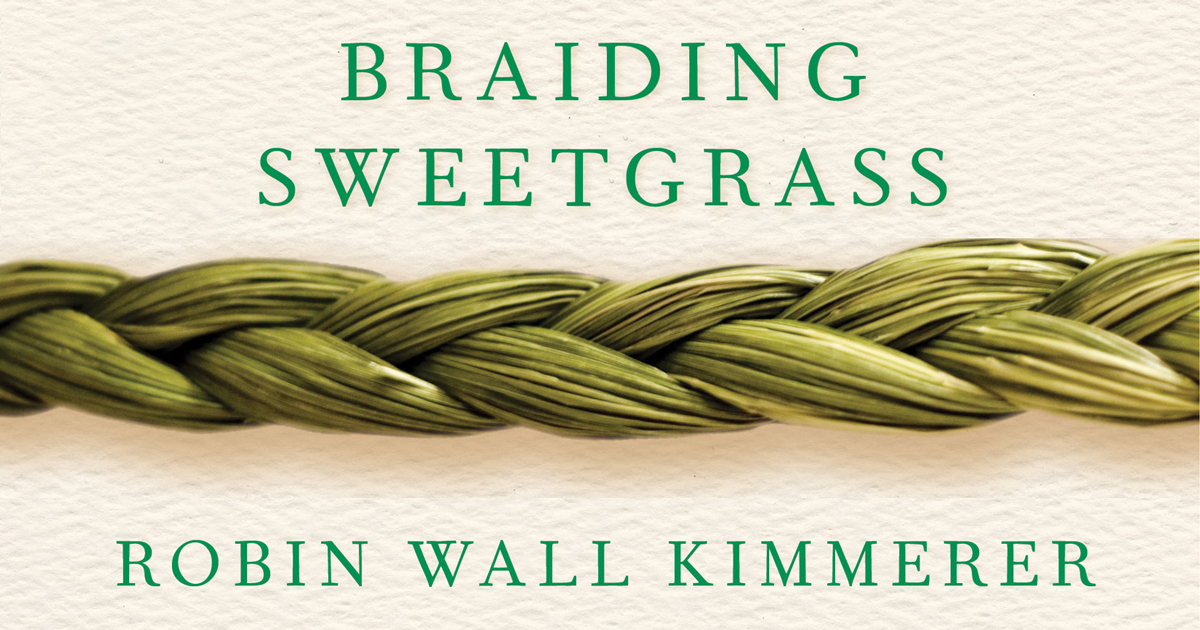By Laurie Casey
Join a book discussion of "Braiding Sweetgrass" at 7 p.m. Thursday, Aug. 15, at Trailside Museum of Natural History, 738 Thatcher Ave., in River Forest. Sponsored by the Nature Book Club of the Forest Preserves of Cook County.
This collection of essays was a favorite of GCC’s co-founder, Sally Stovall, who passed away a little more than a month ago. “It opened up a whole new way of looking at things,” she said about the book a few years ago, when she organized a five-week reading group around it. Later, in writing a brief review, Sally wrote, “The stories in each chapter have delighted and nurtured me in a way that I find hard to describe. From the first essay on, I have been sharing my enthusiasm for this book like an evangelist!”
It's no wonder Sally loved this book. The author, Robin Wall Kimmerer, writes richly and beautifully, along the way weaving Native American lore and knowledge about nature among findings from her scientific research. Kimmerer is an ecologist who is also a member of the Citizen Potawatomi Nation. These two identities give her a fascinating perspective on nature and our relationship to it.
In fact, her cultural wisdom and botanical research often reinforce one another. Take the Sweetgrass basket, a staple of Potawatomi culture. People have been harvesting the grass to make them for centuries and probably millennia. When she and her students studied Sweetgrass plots that were periodically harvested and Sweetgrass plots that weren't, the harvested plots thrived, whereas the non-harvested ones died off. It’s just one example from the book showing how people and nature are often surprisingly dependent on each other.
Kimmerer’s central theme is that we have a duty to take care of the earth and all its gifts. Every day, the earth offers up its bounty to us. A human-centric point of view values these gifts --what we mine, remove, cut down and transform—as things that can improve our quality of life.
But Kimmerer’s idea is much more reciprocal. Giving and receiving in a spirit of gratitude and reverence for nature makes everything around us stronger. “We are showered every day with gifts, but they are not meant for us to keep. Their life is in their movement, the inhale and the exhale of our shared breath. Our work and our joy is to pass along the gift and to trust that what we put out into the universe will always come back,” Kimmerer writes.
Here’s a case in point: Many gardeners know about the “three sisters” --squash, corn and beans -- and how indigenous peoples in the Americas have planted the three together to fertilize and support each other. The beans fix nitrogen in the soil to make it available for the others, the corn provides a trellis for the beans to climb, and the squash leaves shade the soil to conserve moisture. “It’s tempting to imagine that these three are deliberate in working together, and perhaps they are,” writes Kimmerer, “But the beauty of the partnership is that each plant does what it does in order to increase its own growth. As it happens, when the individuals flourish, so does the whole.”
It’s a true and compelling explanation of community-building and what we at Green Community Connections—in carrying out Sally’s vision – try to achieve. So many of us have drawn personal strength from our belonging, from our connections to others.
Kimmerer goes on to make the point that it’s not a matter of self-denial or subsuming our identities. Rather, self-actualization is the key that makes it all work: “ The most important thing each of us can know is our own unique gift and how to use it in the world…in order for the whole to flourish, each of us has to be strong in who we are and carry our gifts with conviction so they can be shared with others.”
This beautiful book is sometimes sad, especially when it explores how humans ignore our relationship to nature and hurt the land (and ourselves). As our planet burns and scientists tell us we’ve got about a dozen years to turn things around, Kimmerer offers a way out.
Near the end of the book she explores the idea of ecological restoration and argues that the standard definition needs refining to include renewing of relationships between humans and nature, as well as non-human inhabitants and the land.
“Renewal of relationships includes water that you can swim in and not be afraid to touch,” she writes. “Restoring relationships means that when the eagles return, it will be safe for them to eat the fish…Reconnecting people and the landscape is as essential as reestablishing proper hydrology or cleaning up contaminants. It is medicine for the earth.”
While I was reading this book for the first time a few years ago, I visited a small lighthouse museum in Florida. My husband and I took a tour of the grounds, led by a lively and knowledgeable docent who regaled us with tales about the lighthouse and its lore. But whenever I asked him about indigenous people who lived on the land before and during the lighthouse’s prime years, or the plants that lined the paths we walked along, he was dismissive and quite unhelpful.
Disappointed by his pointed disregard for the finer points of the gorgeous ecosystem he was privileged to introduce to hundreds of people each week, a few weeks later I wrote the director and recommended “Braiding Sweetgrass” as a way to teach her docents about the wisdom of plants and indigenous people. She responded by telling me she had read reviews of the book and was purchasing two copies, one for the museum’s use and one for her own personal library. I don’t think I ever told Sally Stovall this story, but I think she would have approved of me “evangelizing” the book in this way.

